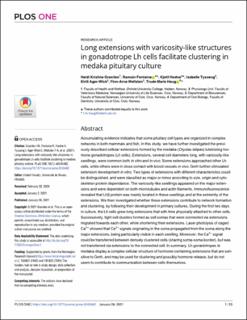| dc.description.abstract | Accumulating evidence indicates that some pituitary cell types are organized in complex networks in both mammals and fish. In this study, we have further investigated the previously described cellular extensions formed by the medaka ( Oryzias latipes ) luteinizing hormone gonadotropes (Lh cells). Extensions, several cell diameters long, with varicosity-like swellings, were common both in vitro and in vivo . Some extensions approached other Lh cells, while others were in close contact with blood vessels in vivo . Gnrh further stimulated extension development in vitro . Two types of extensions with different characteristics could be distinguished, and were classified as major or minor according to size, origin and cytoskeleton protein dependance. The varicosity-like swellings appeared on the major extensions and were dependent on both microtubules and actin filaments. Immunofluorescence revealed that Lhβ protein was mainly located in these swellings and at the extremity of the extensions. We then investigated whether these extensions contribute to network formation and clustering, by following their development in primary cultures. During the first two days in culture, the Lh cells grew long extensions that with time physically attached to other cells. Successively, tight cell clusters formed as cell somas that were connected via extensions migrated towards each other, while shortening their extensions. Laser photolysis of caged Ca 2+ showed that Ca 2+ signals originating in the soma propagated from the soma along the major extensions, being particularly visible in each swelling. Moreover, the Ca 2+ signal could be transferred between densely clustered cells (sharing soma-soma border), but was not transferred via extensions to the connected cell. In summary, Lh gonadotropes in medaka display a complex cellular structure of hormone-containing extensions that are sensitive to Gnrh, and may be used for clustering and possibly hormone release, but do not seem to contribute to communication between cells themselves. | en_US |

